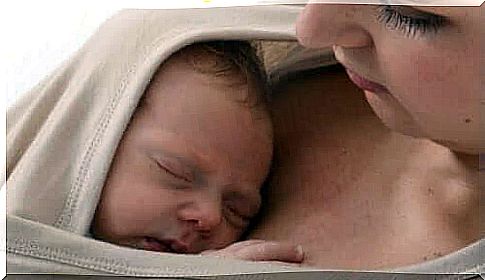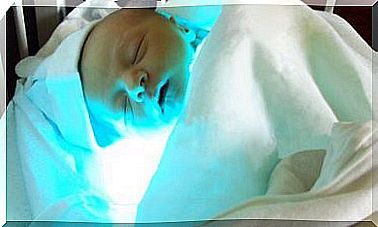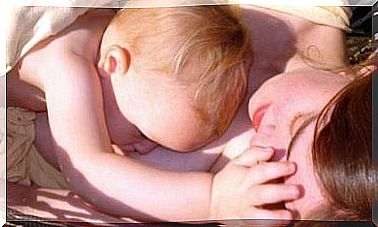The Importance Of Skin Contact After Birth

Skin contact after birth is also called the kangaroo method and involves placing the newborn baby on your mother’s naked breasts. This contact is important as soon as the baby is born, especially in the case of premature babies.
The idea is to avoid unnecessary separation between mother and child after childbirth. All other routine activities and examinations can wait because the child does not need any of it right then.
A distinction is made between immediate skin contact and early skin contact. The first occurs immediately after a child is born. The second occurs within the first half hour.
When babies are born, many hospitals routinely perform a series of examinations and tests, as well as bathe, weigh and dress the little ones. They also put on their identification bracelets or footbands.
Today, however, more and more hospitals are incorporating skin contact as part of their protocol. It is important that hospitals start looking more closely at what procedures they want for their newborns and that they change their protocols to postpone what is not urgent… except in special cases when the infant really needs it.
During caesarean section, some hospitals allow the kangaroo method directly in the operating room. Others allow the father, or any other person chosen by the mother, to be the first to offer skin contact for the little baby.

The story behind the kangaroo method
Pediatricians Edgar Rey and Hector Martinez first introduced the kangaroo method to newborns in 1979, at San Juan de Dios Hospital in Bogotá, Colombia. They used the method specifically to care for premature babies.
As the country suffered from a shortage of hospital equipment, they created the method as an alternative to putting premature babies in an incubator. They got their inspiration from how kangaroos take care of their cubs.
In developing countries, studies have shown many benefits of the method, such as a reduction in the number of infections and fewer problems with breastfeeding. In addition, women who use the kangaroo method feel that they gain greater self-confidence.
In South Africa, the kangaroo method was introduced in the 80’s by the Swedish pediatrician and neonatologist Nils Bergman. According to Bergman, the first minutes of life mark the rest of a child’s existence.
Skin contact is part of the ten steps in the “Initiative for a more humane birth and breastfeeding.” This initiative has spread around the world with the support of the United Nations Children’s Fund (UNICEF) and the World Health Organization (WHO).
Throughout human history, mothers have offered their newborns protection, warmth, social stimulation and nourishment. Modern medicine, however, has introduced routines that mean that children are separated from their mothers early.
The benefits of skin contact
A variety of studies have shown that skin contact is better for newborns than lying in an incubator.
- The kangaroo method makes it possible for newborns to better adapt to their new environment. It improves oxygenation and stabilizes heart rate and respiration. It also reduces the time that babies cry after birth.
- Stabilizes the baby’s body temperature.
- Increases the chance of successful breastfeeding and attachment. A study of unproblematic full-term and premature births in New York demonstrated this. Of all participating mothers, 72% said they had a desire to breastfeed. But of these 72%, only 28% actually continued with it, and the rest started feeding with a baby bottle. Of these 28%, all had used the kangaroo method in the delivery room.
- Increases oxytocin levels, which have a de-stressing effect on mothers, improves the contraction of the uterus and promotes the flow of colostrum.
- Favors colonization of the newborn baby’s digestive system and skin by absorbing the mother’s bacterial flora.

The consequences of separating newborns from their mothers
The premature separation of newborns from their mothers has a series of negative consequences that are important to avoid. For example:
- Complicates the connection: Separating a newborn from his mother inhibits the development of a child’s ability to recognize his mother’s scent.
- Slows recovery from stress at birth.
- Increases the amount of energy required for the newborn’s digestive system to adapt and slows down this process. The separation causes hypothermia in newborns, which the body tries to counteract by initiating vasoconstriction. This leads to increased glucose consumption and metabolic acidosis.
- Newborns who undergo a premature separation from their mothers sleep less and cry more.
- These babies also have more difficulty breastfeeding. When newborns miss the “golden hour”, they lose the opportunity to reach their mother’s breasts on their own.
More consequences of separating newborns from their mothers
Most newborn animals that are separated from their mothers and then reunited are rejected. In many cases, their mothers can even kill them. The consequences are less dramatic among people, but are still something we must take seriously.
Human mothers spend 9 months waiting for a wave of love and maternal attachment. Unfortunately, they often come across something very unexpected: separation. It is all too common for mothers to have to wait to hold on to their newborns. And it’s easy to understand how frustrating and disappointing this is.
In addition, childbirth is stressful for infants, and they need to recover. To do so, they need their mothers and the familiar sounds that their breathing and heartbeat have on them to make them feel safe. Therefore, we can not underestimate or devalue a method that is so simple, free and has so many benefits… for both mother and child.
As you can see, it is so important for expectant mothers to be aware of the importance of early skin contact with their children. If you are pregnant, you should discuss this with your midwife when writing your birth plan. In addition, you can ask what protocols the hospital where you will give birth have for the time after the birth and ask that they put your baby with you as soon as the baby is born, if possible.









